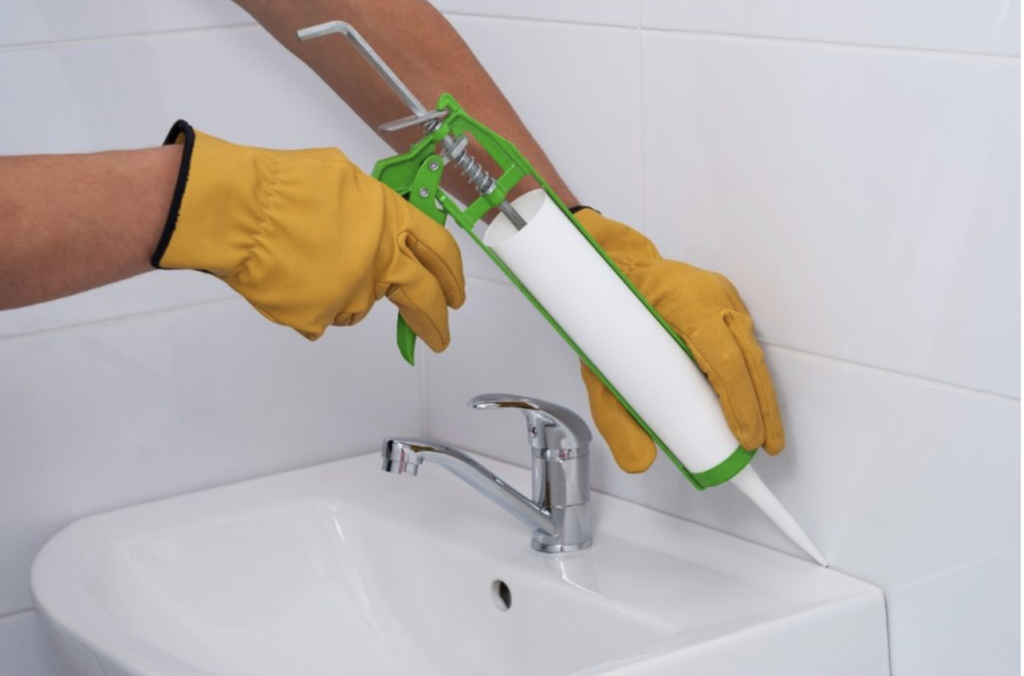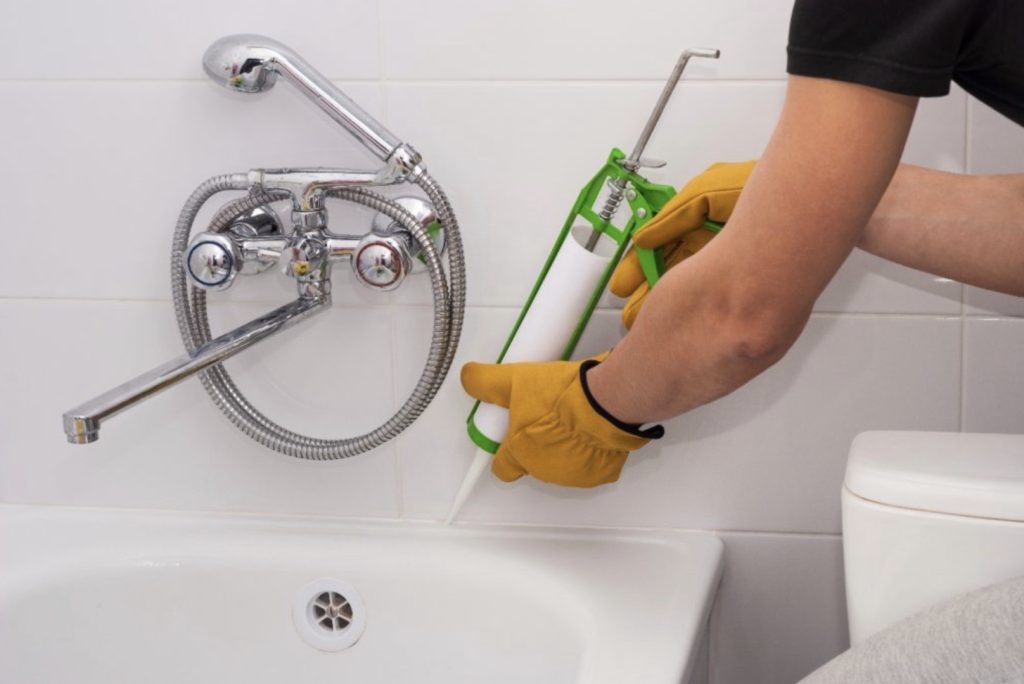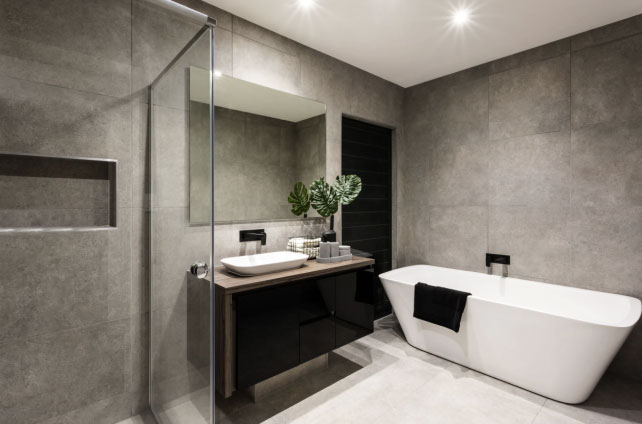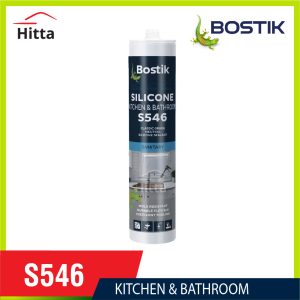The purpose of waterproof and water-resistant adhesives and sealants is to fill and protect surfaces in high-moisture areas. Using waterproof and water-resistant adhesives and sealants is crucial because these sealants not only protect various materials but also enhance the aesthetics of the entire room.
If joints are left unsealed or improperly sealed, these areas are susceptible to water damage, bacterial growth, and mold, leading to deterioration and quicker wear and tear.
Kitchen sinks, bathrooms, showerheads, bathtubs, toilets, and hand sinks are the most frequently used fixtures in every household, and therefore, attention to cleanliness in these areas is essential for ensuring health and hygiene.
What are water-resistant and waterproof adhesive?
Waterproof adhesive, also known as water-resistant adhesive, is a type of adhesive that can withstand water and is not affected by humid environments. It is commonly used to bond materials in wet areas such as bathrooms, swimming pools, food processing plants, and areas exposed to damp weather.
Waterproof adhesives are made from polymer compounds that have water-resistant properties, typically polyurethane or silicone. These compounds enable the adhesive to maintain its bonding capability and durability, even when exposed to water.
To achieve the maximum effectiveness of waterproof adhesive, it is essential to choose the appropriate type of adhesive for the environment and materials being bonded to ensure optimal bonding performance and durability. Some types of waterproof adhesives are designed to withstand chemicals and resist decay in moist environments.
Selecting a suitable waterproof and water-resistant adhesive

There are various types of waterproof sealants available. However, besides effectively sealing and waterproofing, a good waterproof sealant should:
- Mold Resistance: Areas like bathrooms and kitchens are often damp and dark, creating ideal conditions for mold and bacterial growth. To prevent the growth of bacteria and mold and ensure maximum hygiene, ensure that the waterproof sealant has mold-resistant properties.
- Permanent Flexibility: The sealant material needs to be strong enough to create a permanent bond with the sealed surfaces and have enough elasticity to accommodate movement at the joint.
- Ease of Cleaning: Since waterproof sealants will frequently come into contact with household chemicals and water, they should have a smooth, easy-to-clean surface that does not trap dirt and is resistant to water flow.
- Anti-Aging Properties: Many waterproof sealants may discolor over time. Anti-aging properties mean that the sealant will not change color over time or be affected by common household chemicals such as hair dye, soap, and shampoo.
- Quick Curing: The faster the waterproof sealant cures, the less chance there is of dust adhering to the surface of the joint. Additionally, customers also want to use the room as soon as possible after application.
- Health Safety: Always choose products with the lowest possible Volatile Organic Compound (VOC) content to ensure health safety.
In addition to the factors listed above, when choosing waterproof sealants, it is essential to check the compatibility of the product with the materials to be sealed. Typically, neutral cure or acetoxy silicone is used.
The main difference between these two types of sealants is that neutral cure silicone can be used to seal untreated metals and natural stone surfaces (such as marble or granite countertops).
On the other hand, acetoxy silicone has advantages in terms of mold resistance and anti-aging properties. An additional benefit is that for joints between glass and glass, such as sealing glass partitions, acetoxy silicone waterproof sealants are significantly more translucent than similar neutral cure silicone.
It is worth noting that due to the chemical nature of silicone, it cannot be painted over. Therefore, it is essential to choose the correct color silicone sealant that matches the sealed surfaces from the start.
Ensure that you use the correct type of waterproof sealant, apply it correctly, and perform regular maintenance to ensure that waterproof joints remain sharp and clean for many years to come.
Waterproof & Leak-proof Bathroom Sealant

A good waterproof sealant for bathrooms must be water-resistant, mold-resistant, and solvent-free. These qualities create a bonding agent capable of withstanding bathroom conditions and maintaining integrity for years to come.
Water Resistance & Waterproofing
Whether applying waterproof sealant to toilets, sinks, or showerheads, the primary criterion must be water resistance.
If there’s a crack on the bathroom wall or floor, water can seep through, leading to potentially serious issues. A good sealant will prevent water leakage.
Waterproof sealant also needs to protect electrical fixtures such as light fixtures or switches from water and steam. Waterproof silicone sealant is the perfect choice for installing and maintaining pads on bathroom fixtures. Silicone remains stable at both high and low temperatures, making it able to withstand continuous temperature changes in the bathroom.
Mold Resistance
Bathrooms are ideal environments for mold growth, especially black mold, which can pose health hazards if left untreated or removed. Since bathrooms are often the warmest and most humid rooms in the house, they are most prone to mold. Therefore, remember that good waterproof and mold-resistant sealants for bathrooms must have high mold resistance to ensure that mold cannot grow or proliferate on the surface.
Silicone sealant is one of the best waterproof and mold-resistant sealants available. Due to silicone’s natural properties, silicone sealant typically has higher mold resistance compared to regular mortar, and some silicone sealants also include fungicides, antibacterial agents, or mold-resistant compounds to provide better protection.
While mold may still develop on waterproof and mold-resistant silicone sealants over time, the frequency of cleaning or replacing the joint will be significantly reduced compared to before.
Solvent-Free
The final quality to consider is that the sealant should be solvent-free. Solvent-free sealants typically have a water-based composition and contain less than 5% solvent.
Solvent-free sealants are more environmentally friendly and safer to use in small spaces like bathrooms because solvent-free waterproof and mold-resistant sealants typically have little to no odor and are less harmful when passively inhaled.
Solvent-free bonding agents are also reported to have higher initial bonding strength than solvent-based bonding agents, so there’s no need to compromise performance for safety!
Silicone sealant is available in both clear and white. However, generally, people will choose to use white sealant if the bathroom fixtures are white and then opt for clear sealant if it’s any other color.
Silicone vs. Hybrid
Hybrid waterproof and mold-resistant sealants offer a flexible and balanced solution: the best combination of mortar and bonding agents such as polyurethane, silicone, acrylic, and rubber. Key advantages include: can be applied on wet surfaces, high durability, excellent adhesion, no yellowing, no odor emission, and most importantly, resistance to mold formation. However, due to its excellent adhesion and high durability, hybrid sealants may be more difficult to remove if necessary.
Waterproof and mold-resistant silicone sealants can be either acidic or neutral depending on the curing system. Acidic sealants emit a pungent acetic acid odor when used, while neutral sealants have almost no odor. Acidic types are used on stainless steel, glass, ceramics, wood, but are not compatible with alkaline materials (concrete, lime, gypsum), marble, granite, causing metal corrosion. Neutral types can be used without limitations.
Which waterproof and water-resistant glue is good for you?
Hitta would like to introduce Bostik, a French brand renowned for its specialized waterproof and mold-resistant adhesive product, Bostik S546, which is based on neutral silicone. Here are its key advantages:
- Solvent-Free Curing: Bostik S546 cures without the need for solvents, making it environmentally friendly and safer to use.
- Versatile Bonding: It adheres well to a wide range of materials, providing reliable bonding for various applications.
- Permanent Elasticity: The adhesive maintains permanent elasticity, allowing it to accommodate movements without losing its bond, ensuring long-lasting performance.
- Mold Resistance: Bostik S546 is formulated to resist mold growth, making it ideal for environments prone to moisture and mold, such as bathrooms and kitchens.
- UV and Weather Resistance: It offers excellent resistance to UV rays and weathering, ensuring durability and stability even when exposed to outdoor elements.
Bostik S546 is a reliable choice for sealing and bonding applications that require superior waterproofing and mold resistance.
Contact us
Hitta’ is the official authorized distributor of Bostik. Please contact us for detailed consultation with our specialists as well as to purchase the products at the best prices:
 Hotline: 056 533 6879
Hotline: 056 533 6879 Email: hittajsc@hitta.vn
Email: hittajsc@hitta.vn
solutions you may be interested in


